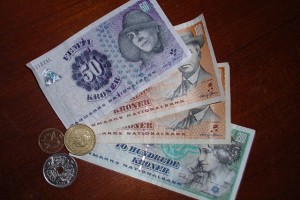 Yesterday’s trade saw USD/DKK within the range of 6.5345-6.6048. The pair closed at 6.5992, soaring 0.92% on a daily basis. It has been the 10th gain in the past 22 trading days, a second consecutive one and also the steepest one since January 29th, when the exotic cross advanced 0.97%. In addition, the daily high has been the highest level since March 30th, when a high of 6.6065 was registered. In weekly terms, USD/DKK edged down 0.20% during the past week to mark its 9th drop in 14 weeks and also a second consecutive one. USD/DKK has increased its advance to 0.95% so far during the current month, following two consecutive months of decline. In March it fell 4.55%.
Yesterday’s trade saw USD/DKK within the range of 6.5345-6.6048. The pair closed at 6.5992, soaring 0.92% on a daily basis. It has been the 10th gain in the past 22 trading days, a second consecutive one and also the steepest one since January 29th, when the exotic cross advanced 0.97%. In addition, the daily high has been the highest level since March 30th, when a high of 6.6065 was registered. In weekly terms, USD/DKK edged down 0.20% during the past week to mark its 9th drop in 14 weeks and also a second consecutive one. USD/DKK has increased its advance to 0.95% so far during the current month, following two consecutive months of decline. In March it fell 4.55%.
At 8:11 GMT today USD/DKK was gaining 0.22% on the day to trade at 6.6139. The pair touched a daily high at 6.6250 at 7:23 GMT, or the highest level since April 12th, and a daily low at 6.5956 during early Asian trade.
On Thursday USD/DKK trading may be influenced by the following macroeconomic reports and other events as listed below.
Fundamentals
United States
Initial, Continuing Jobless Claims
The number of people in the United States, who filed for unemployment assistance for the first time during the business week ended on April 8th, probably increased to 270 000, according to market expectations, from 267 000 in the preceding week.
The 4-week moving average, an indicator lacking seasonal effects, was 266 750, marking an increase by 3 500 compared to the preceding weeks unrevised average.
The business week, which ended on April 1st has been the 57th consecutive week, when jobless claims stood below the 300 000 threshold, which suggested a healthy labor market. This has been the longest streak since 1973.
Initial jobless claims number is a short-term indicator, reflecting lay-offs in the country. In case the number of claims met expectations or increased further, this would have a moderate bearish effect on the US dollar.
The number of continuing jobless claims probably dropped to the seasonally adjusted 2 183 000 during the business week ended on April 1st from 2 191 000 in the preceding week. The latter has been the highest number of claims since the business week ended on March 4th, when a revised down 2 218 000 claims were reported. The figure also represented an increase by 19 000 compared to the revised down number of claims reported in the week ended on March 18th. This indicator reflects the actual number of people unemployed and currently receiving unemployment benefits, who filed for unemployment assistance at least two weeks ago.
The Department of Labor is to release the weekly report at 12:30 GMT.
Consumer inflation
The annualized consumer inflation in the United States probably accelerated to 1.2% in March, according to market expectations, from 1.0% in February. In monthly terms, the Consumer Price Index (CPI) probably rose 0.2% in March, following a 0.2% drop in the preceding month.
In February upward pressure came from cost of services less energy (up 3.1% year-on-year and following a 3.0% surge in January). Within the category, cost of shelter went up 3.3% year-on-year, cost of medical care rose 3.9% and cost of transportation services increased 2.6%. Additionally, consumers paid more for food in February (up at an annualized rate of 0.9%, accelerating from a 0.8% surge in January), according to the report by the Bureau of Labor Statistics. The largest downward pressure on the annual CPI came from prices of energy (down 12.5% in February from a year ago, or a steeper decline compared to January).
The annualized core consumer inflation, which is stripped of prices of food and energy, probably remained at 2.3% for a second consecutive month in March, according to expectations. It has been the highest core inflation since May 2012.
If the general CPI tends to approach the inflation objective, set by the Federal Reserve and considered as providing price stability, or a level below but close to 2%, this will usually bolster the appeal of the US dollar, as it heightens the probability of monetary policy tightening.
The Bureau of Labor Statistics is to release the official CPI report at 12:30 GMT.
Fed Speakers
At 14:00 GMT the Fed President for Atlanta, Dennis Lockhart, and Fed Board of Governors member, Jerome Powell are expected to take a statement. These events will be closely watched by market players for hints over how the central banks tightening cycle will develop in the future.
Daily and Weekly Pivot Levels
By employing the Camarilla calculation method, the daily pivot levels for USD/DKK are presented as follows:
R1 – 6.6056
R2 – 6.6121
R3 (range resistance) – 6.6185
R4 (range breakout) – 6.6379
S1 – 6.5928
S2 – 6.5863
S3 (range support) – 6.5799
S4 (range breakout) – 6.5605
By using the traditional method of calculation, the weekly pivot levels for USD/DKK are presented as follows:
Central Pivot Point – 6.5319
R1 – 6.5671
R2 – 6.6056
R3 – 6.6408
S1 – 6.4934
S2 – 6.4582
S3 – 6.4197





